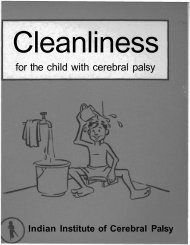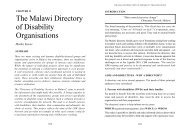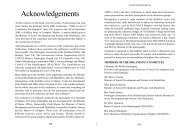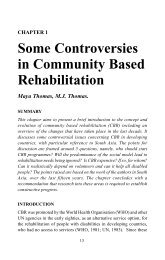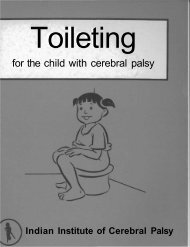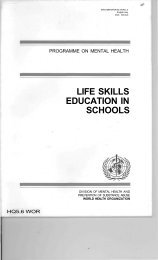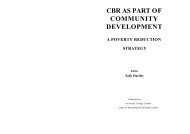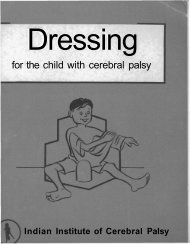Feeding for the child with cerebral palsy - Source
Feeding for the child with cerebral palsy - Source
Feeding for the child with cerebral palsy - Source
You also want an ePaper? Increase the reach of your titles
YUMPU automatically turns print PDFs into web optimized ePapers that Google loves.
<strong>Feeding</strong><br />
<strong>for</strong> <strong>the</strong> <strong>child</strong> <strong>with</strong> <strong>cerebral</strong> <strong>palsy</strong><br />
Indian Institute of
2806236585<br />
FEEDING<br />
<strong>for</strong> <strong>the</strong> <strong>child</strong> <strong>with</strong> <strong>cerebral</strong> <strong>palsy</strong><br />
Ranu Banerjee<br />
Madhuchhanda Kundu<br />
Arundhuti Banerjee<br />
Illustrations<br />
Bela Purohit<br />
Design<br />
Himalini Varma<br />
Edited by<br />
Anjana Jha<br />
AHRTAS<br />
iMT<br />
2P-36 rARRiNGOUN ROAD<br />
LONDON £••/' 3 JB (U.K.)<br />
TEL: 0;?1-2'i2-0oU6<br />
AcqulGition No. r -
IICP PUBLICATIONS<br />
EPILEPSY<br />
SPECIAL FURNITURE<br />
YOU AND YOUR BABY<br />
LEARNING AT HOME<br />
BEHAVIOUR MANAGEMENT<br />
PLAY FOR THE CHILD WITH CEREBRAL PALSY<br />
TOILETING FOR THE CHILD WITH CEREBRAL PALSY<br />
DRESSING FOR THE CHILD WITH CEREBRAL PALSY<br />
CLEANLINESS FOR THE CHILD WITH CEREBRAL PALSY<br />
FEEDING FOR THE CHILD WITH CEREBRAL PALSY<br />
COMMUNICATION FOR THE CHILD WITH CEREBRAL PALSY<br />
VOCATIONAL TRAINING FOR THE CHILD WITH CEREBRAL PALSY<br />
PHYSICAL MANAGEMENT FOR THE CHILD WITH CEREBRAL PALSY<br />
IICP, Calcutta, 1995<br />
Published by:<br />
Indian Institute of Cerebral Palsy<br />
Spastics Society of Eastern India<br />
P-35/1, Taratolla Road<br />
Calcutta 700 088<br />
Phone: 478 3488/478 4177<br />
Laser composed by: Computec Systems, 8 Siddhaswari Road, Calcutta - 700 029.<br />
Printed by: Systems, 6A Ramanath Majumder Street, Calcutta - 700 009.
CONTENTS<br />
Acknowledgements<br />
Foreword<br />
Positioning<br />
• Seating your <strong>child</strong> on <strong>the</strong> lap<br />
• Independent sitting<br />
• Adapted floor seating<br />
• Adapted chairs<br />
• Positioning <strong>for</strong> special problems<br />
Eating<br />
• Food<br />
• <strong>Feeding</strong> <strong>with</strong> a spoon<br />
• Chewing<br />
• Biting<br />
• Swallowing<br />
• Drooling<br />
• Choking<br />
1<br />
1<br />
2<br />
3<br />
5<br />
7<br />
9<br />
10<br />
11<br />
12<br />
13<br />
13<br />
14<br />
15
• Vomiting<br />
• Problem behaviour during eating<br />
• Rinsing<br />
• Eating <strong>with</strong>out help<br />
• Special spoons<br />
• Types of plates<br />
• Teaching independent eating<br />
• Teaching o<strong>the</strong>r skills while feeding<br />
Drinking<br />
17<br />
17<br />
18<br />
20<br />
21<br />
23<br />
24<br />
28<br />
29
Acknowledgements<br />
The authors gratefully acknowledge <strong>the</strong> assistance received from<br />
<strong>the</strong> Rajiv Gandhi Foundation. Special thanks must also be given to all<br />
staff members of <strong>the</strong> Spastics Society of Eastern India and to all parents.<br />
Sponsored by Overseas Development Administration, U.K.
Foreword<br />
Barely three decades ago, <strong>the</strong> majority of <strong>child</strong>ren <strong>with</strong> severe developmental<br />
disabilities like <strong>cerebral</strong> <strong>palsy</strong> were regarded as ineducable. However,<br />
in <strong>the</strong> last few years, <strong>the</strong>re has been a marked increase in <strong>the</strong> awareness of<br />
<strong>cerebral</strong> <strong>palsy</strong> and its implications. The most significant realisation has been <strong>the</strong><br />
fact that <strong>the</strong> education of a <strong>child</strong> <strong>with</strong> a disability is not concerned merely <strong>with</strong> his<br />
intellectual development. The management of a <strong>child</strong> in every sphere of daily<br />
living is of equal importance. Consequently, an interdisciplinary and integrated<br />
approach is essential <strong>for</strong> achieving <strong>the</strong> maximum progress of a <strong>child</strong>.<br />
Parents play a primary role in teaching <strong>the</strong>ir <strong>child</strong> <strong>the</strong> various skills of daily living.<br />
Undoubtedly, <strong>the</strong> parents have <strong>the</strong> best understanding of <strong>the</strong>ir disabled <strong>child</strong>, but<br />
<strong>the</strong>y may often be unaware of <strong>the</strong> best way to go about this enormous task.<br />
The Indian Institute of Cerebral Palsy (IICP) is <strong>the</strong> training and research division of<br />
<strong>the</strong> Spastics Society of Eastern India. The need <strong>for</strong> more in<strong>for</strong>mation on <strong>cerebral</strong><br />
<strong>palsy</strong> has long been felt both by parents and professionals. With this objective in<br />
mind, <strong>the</strong> IICP has planned to produce a series of books and booklets, written by<br />
a team of special educators, <strong>the</strong>rapists and social workers. It is hoped that <strong>the</strong><br />
easy-to-follow guidelines and illustrations will help parents in <strong>the</strong> daily management<br />
programme of <strong>the</strong>ir <strong>child</strong>.<br />
A disabled <strong>child</strong> has <strong>the</strong> desire as well as <strong>the</strong> ability to learn different skills. With<br />
time, ef<strong>for</strong>t and constant encouragement, he will eventually achieve results to <strong>the</strong><br />
best of his ability.
Many <strong>child</strong>ren <strong>with</strong> <strong>cerebral</strong> <strong>palsy</strong> have problems in eating and drinking<br />
which can cause a lot of difficulty <strong>for</strong> <strong>the</strong> parents. However <strong>with</strong> appropriate<br />
management, <strong>the</strong>se problems can be reduced considerably.<br />
It is important to remember that <strong>the</strong> sooner correct management is introduced,<br />
<strong>the</strong> better are <strong>the</strong> chances of reducing <strong>the</strong> problems. The first step to appropriate<br />
management is seating your <strong>child</strong> correctly while he is eating and drinking.<br />
POSITIONING<br />
Mentioned below are some ways of seating your <strong>child</strong> which will be more com<strong>for</strong>table<br />
<strong>for</strong> him. The positions will also make it easier <strong>for</strong> you to feed him.<br />
SEATING YOUR CHILD ON THE LAP<br />
A mo<strong>the</strong>r usually feeds a <strong>child</strong> who is very<br />
young by making him sit on her lap.<br />
Let your <strong>child</strong> sit on your lap. Place your<br />
arm around his neck so that his head is<br />
kept straight and facing <strong>for</strong>ward. This<br />
position is suitable while he is being fed or<br />
given a drink.<br />
Do not feed your <strong>child</strong> while he is lying on your lap as <strong>the</strong>re is a danger<br />
of choking.<br />
To make feeding and drinking easier <strong>for</strong> your <strong>child</strong>, try and get your <strong>child</strong> to sit by<br />
himself on <strong>the</strong> floor or on a chair if he can! It will also make him more independent.
INDEPENDENT SITTING<br />
If your <strong>child</strong> can sit by himself, you can<br />
place him on <strong>the</strong> floor <strong>for</strong> feeding. A<br />
floor table can be put in front of him. In<br />
this way, he will spill food while eating.<br />
You can also seat him on a chair <strong>with</strong> a<br />
table kept in front. The height of <strong>the</strong><br />
chair should be such that his feet are<br />
flat on <strong>the</strong> ground.<br />
It is more convenient to feed your <strong>child</strong><br />
when you sit facing him.
ADAPTED FLOOR SEATING<br />
If your <strong>child</strong> cannot sit by himself on <strong>the</strong> floor or on a chair, placing him in one of<br />
<strong>the</strong> following positions may be helpful.<br />
If your <strong>child</strong> has not learnt to sit by himself<br />
<strong>with</strong>out support, <strong>the</strong>n seat him<br />
against <strong>the</strong> wall and place a floor table<br />
in front of him. The table will give him<br />
support from <strong>the</strong> front.<br />
if <strong>the</strong> floor table does not give enough<br />
support, your <strong>child</strong> may still tend to fall<br />
sideways. In this case, a cut-out table<br />
will be more com<strong>for</strong>table. It will fit<br />
around his chest and also give support<br />
to his elbows. i<br />
If your <strong>child</strong> needs more support, <strong>the</strong>n<br />
make her sit in <strong>the</strong> corner of a room on<br />
a cushion or on a rolled up blanket.<br />
Place a floor table or a cut-out table in<br />
front of her to provide additional support.
If you find that your <strong>child</strong> is pushing away<br />
<strong>the</strong> cut-out table, you can fix it to <strong>the</strong><br />
wall <strong>with</strong> latches. This will secure it firmly<br />
in place while <strong>the</strong> <strong>child</strong> is being fed or is<br />
eating by herself.<br />
You may find it difficult to seat your <strong>child</strong> in <strong>the</strong> positions mentioned earlier due to<br />
his physical problems or his lack of understanding. A list of adapted seats is<br />
given below. When you choose a seat <strong>for</strong> your <strong>child</strong>, consider <strong>the</strong> difficulties he<br />
has as well as <strong>the</strong> space available in your house.<br />
If your <strong>child</strong> is able to hold up his head,<br />
place him in a corner seat. If he tends to<br />
fall or slip <strong>for</strong>ward, fix a cylindrical block<br />
of wood in <strong>the</strong> seat between his legs. This<br />
will prevent him from slipping <strong>for</strong>ward.<br />
Try using a floor seat if your <strong>child</strong> still<br />
continues to have problems. This kind<br />
of seat will give more support to <strong>the</strong> back<br />
and sides. If he slips <strong>for</strong>ward while sitting,<br />
<strong>the</strong>n fix a cylindrical block of wood<br />
on <strong>the</strong> seat between <strong>the</strong> <strong>child</strong>'s legs.
Your <strong>child</strong> can be fed while he is sitting in<br />
a corner seat or a floor seat by placing a<br />
small floor table or a cut-out table in front<br />
of him.<br />
ADAPTED CHAIRS<br />
If your <strong>child</strong> finds it difficult to sit on a chair<br />
<strong>with</strong>out arms, make him sit on a chair <strong>with</strong><br />
arms and place a table in front of him.<br />
The chair should be of <strong>the</strong> correct<br />
measurement and height so that his<br />
thighs are supported by <strong>the</strong> seat and<br />
his feet are resting flat on <strong>the</strong> ground.<br />
If <strong>the</strong> chair is too high, you can place<br />
a stool under his feet.<br />
In case your <strong>child</strong> tends to slip off <strong>the</strong><br />
chair, fix a cylindrical block of wood<br />
on <strong>the</strong> seat of <strong>the</strong> chair.
If your <strong>child</strong> is on a wheelchair, <strong>the</strong>n use a cut-out tray.<br />
Two long pieces of wood are attached<br />
length-wise underneath <strong>the</strong> cut-out tray,<br />
at both ends. Grooves are cut on <strong>the</strong>se<br />
pieces which enable you to slide <strong>the</strong> tray<br />
over <strong>the</strong> arms of <strong>the</strong> wheelchair and hold<br />
it firmly in place.<br />
If <strong>the</strong> tray still tends to slip <strong>for</strong>ward,<br />
attach two hooks on ei<strong>the</strong>r side of <strong>the</strong><br />
cut-out tray. Put some thick string or<br />
cloth through <strong>the</strong>se hooks and tie <strong>the</strong><br />
tray securely to <strong>the</strong> wheelchair.<br />
Be<strong>for</strong>e you make your <strong>child</strong> sit on his new seat to feed him, let him use <strong>the</strong> seat<br />
during play or any o<strong>the</strong>r activity. This will ensure that he does not feel uncom<strong>for</strong>table<br />
or insecure during feeding. Your <strong>child</strong> should use <strong>the</strong> seat regularly in order<br />
to get used to it.
POSITIONING FOR SPECIAL PROBLEMS<br />
Sometimes it might be difficult <strong>for</strong> you to feed your <strong>child</strong> even <strong>with</strong> <strong>the</strong> help of <strong>the</strong><br />
adapted seats. This may be due to <strong>the</strong> following reasons:<br />
• The <strong>child</strong> may keep his head<br />
stiffly turned to any one side or<br />
push it backwards.<br />
Hold <strong>the</strong> top of his head <strong>with</strong> one hand<br />
and help him to face <strong>for</strong>ward, keeping<br />
his head straight. This will make it easier<br />
<strong>for</strong> you to handle him during feeding.<br />
You may also find it difficult to feed<br />
him if he cannot control <strong>the</strong> movement<br />
of his arms during feeding.
After putting him on his adapted seat,<br />
tie a pair of gaiters on his arms to keep<br />
<strong>the</strong>m straight.<br />
If his head tends to extend backwards,<br />
hold <strong>the</strong> top of his head firmly and bring<br />
it <strong>for</strong>ward.<br />
Put gaiters on his arms if <strong>the</strong>y come in <strong>the</strong> way of his plate. Help him to hold on<br />
to <strong>the</strong> end of <strong>the</strong> table or a fixed peg in order to prevent his arms from moving<br />
around.<br />
However, if he is moving his arms purposely, <strong>the</strong>n you may have to initially keep<br />
<strong>the</strong> food on a separate table.<br />
8
EATING<br />
It is important to start teaching a handicapped <strong>child</strong> to eat independently as early<br />
as possible. The earlier you start <strong>the</strong> training, <strong>the</strong> better will be <strong>the</strong> progress.<br />
It is important to keep a few things in mind be<strong>for</strong>e you start teaching your <strong>child</strong>.<br />
If your <strong>child</strong> is still on a liquid diet, gradually start giving him solid food such as<br />
a. Suji and milk or bread and milk.<br />
Start giving him solid food like rice or roti to help him to learn to bite and<br />
chew.<br />
b. Use a steel spoon which is nei<strong>the</strong>r too deep nor too big <strong>for</strong> your <strong>child</strong>'s<br />
mouth.<br />
c. A <strong>child</strong> <strong>with</strong> a physical disability often does not move around as much as<br />
o<strong>the</strong>r <strong>child</strong>ren. There<strong>for</strong>e, he may need less food, especially carbohydrates.<br />
Hence food such as potatoes, rice, bread, ghee and butter should<br />
not be given too often. It may make your <strong>child</strong> gain weight and make it<br />
more difficult <strong>for</strong> him to move<br />
Do not overfeed him. A <strong>child</strong> who is never hungry is not likely to cooperate<br />
when you try and feed him. Overfeeding may also make him vomit.<br />
d. It is very important to remember to place your <strong>child</strong> in a correct position.<br />
(Refer to <strong>the</strong> earlier section on 'Positioning'.) It will be much easier <strong>for</strong><br />
your <strong>child</strong> to learn how to eat if he is sitting com<strong>for</strong>tably. Ensure that his<br />
head is slightly <strong>for</strong>ward. This will help him to chew and swallow <strong>the</strong> food<br />
more easily.
FOOD<br />
It is important that you teach your handicapped <strong>child</strong> to eat normal solid food as<br />
early as possible.<br />
If he is four or five months old, he should have semi-solid food like mashed<br />
potato, mashed banana, suji and milk.<br />
By <strong>the</strong> age of 10 or 12 months, he should start eating solid food like rice, roti,<br />
vegetables and fruits.<br />
If your <strong>child</strong> is older but still on a liquid diet, start by giving him semi-solids <strong>with</strong><br />
a spoon.<br />
Once he gets used to semi-solids, gradually start giving him solid food. This will<br />
take time but if you give it regularly, he will learn quickly. He will cooperate more<br />
willingly if you give him <strong>the</strong> solid food when he is hungry. To start <strong>with</strong>, give him<br />
<strong>the</strong> kind of solid food he enjoys.<br />
Give your <strong>child</strong> a variety of food <strong>with</strong> different tastes such as sweet, salty and<br />
sour. Give him <strong>the</strong> opportunity to have an assortment of food <strong>with</strong> different<br />
textures like chips, sugar cane, muri or biscuits.<br />
Give your <strong>child</strong> <strong>the</strong> opportunity to:<br />
a) make a choice of food offered to him<br />
b) refuse what he does not like<br />
c) ask <strong>for</strong> food when he is hungry<br />
d) ask <strong>for</strong> more food during a meal.<br />
He can do this by:<br />
i) pointing to <strong>the</strong> preferred food<br />
ii)<br />
iii)<br />
saying <strong>the</strong> word<br />
pointing to <strong>the</strong> picture of <strong>the</strong> food. You must provide him <strong>with</strong> <strong>the</strong><br />
pictures.<br />
10
FEEDING WITH A SPOON<br />
Mo<strong>the</strong>rs usually start to feed <strong>the</strong>ir <strong>child</strong>ren solid food <strong>with</strong> <strong>the</strong>ir fingers. However,<br />
a <strong>child</strong> <strong>with</strong> <strong>cerebral</strong> <strong>palsy</strong> may have to be taught how to open and close his<br />
mouth as well as how to chew and swallow food. It is easier to teach a <strong>child</strong> to do<br />
this if you use a spoon.<br />
You can sit opposite your <strong>child</strong> to feed<br />
him <strong>with</strong> a spoon. Sometimes you may<br />
find it easier if you sit by his side.<br />
If he does not close his lips over <strong>the</strong><br />
spoon when it is inside his mouth, gently<br />
press his lips toge<strong>the</strong>r around <strong>the</strong><br />
spoon <strong>with</strong> your fingers. Make sure that<br />
you do not scrape <strong>the</strong> food against <strong>the</strong><br />
<strong>child</strong>'s teeth. Then pull out <strong>the</strong> spoon<br />
slowly. Once he learns to close his lips<br />
over <strong>the</strong> spoon, gradually reduce your<br />
help.<br />
11
12<br />
CHEWING<br />
Does your <strong>child</strong> find it difficult to chew?<br />
If your <strong>child</strong> is unable to chew solid food like rice, roti or biscuits, start by giving<br />
him semi-solid food like mashed potato, boiled apple, suji and milk. Gradually<br />
introduce him to normal solid food.<br />
Help him to learn to chew by placing<br />
<strong>the</strong> food in one side of his mouth,<br />
between his cheek and teeth.<br />
Then gently make circular movements<br />
on <strong>the</strong> <strong>child</strong>'s cheeks <strong>with</strong> your fingers.
BITING<br />
Does your <strong>child</strong> find it difficult to bite solid food?<br />
If your <strong>child</strong> finds it difficult to bite solid food like roti, biscuits, toast or fruits, start<br />
by teaching him to bite soft solid food like bananas or finger chips. Introduce <strong>the</strong><br />
solid food gradually.<br />
Help him to learn to bite by placing <strong>the</strong><br />
food between his teeth. You can sit by<br />
his side and place your arm around his<br />
neck. Close his mouth by gently pushing<br />
his chin upward. Be very careful that<br />
you do not push his head back.<br />
SWALLOWING<br />
Dose your <strong>child</strong> find it difficult to swallow food?<br />
Your <strong>child</strong> may be finding it difficult to swallow food because:<br />
• He is not sitting properly. Seat him com<strong>for</strong>tably and keep his head well<br />
<strong>for</strong>ward while he is being fed.<br />
• He is not chewing <strong>the</strong> food properly. Teach him to chew. Refer to 'Biting'<br />
and 'Chewing'.<br />
To help him to swallow, stroke his throat<br />
gently <strong>with</strong> your fingers. Make sure that<br />
you keep his head bent slightly <strong>for</strong>ward<br />
while you do this.<br />
13
DROOLING<br />
Does your <strong>child</strong> drool while eating?<br />
One way to decrease drooling is to continuously remind your <strong>child</strong> to close his<br />
mouth and swallow.<br />
If your <strong>child</strong> cannot follow your instructions,<br />
help him to close his mouth by<br />
gently pressing his lips toge<strong>the</strong>r while<br />
<strong>the</strong> food is in his mouth.<br />
After he has chewed <strong>the</strong> food, gently<br />
stroke his throat <strong>with</strong> your fingers. This<br />
will help him to swallow.<br />
14
CHOKING<br />
Does your <strong>child</strong> choke sometimes while eating?<br />
If your <strong>child</strong> chokes, bend her body<br />
<strong>for</strong>ward and downward.<br />
Never tap your <strong>child</strong> on <strong>the</strong> back or on his head. It may make it worse.<br />
In order to prevent choking, <strong>the</strong> following steps can be helpful:<br />
Always make sure that your <strong>child</strong> is in<br />
an upright position. This is necessary<br />
whe<strong>the</strong>r he is sitting on your lap<br />
or sitting against <strong>the</strong> wall<br />
15
or on a chair.<br />
Always keep his head bent slightly <strong>for</strong>ward.<br />
If <strong>the</strong> head falls back, it may cause<br />
him to choke.<br />
Place <strong>the</strong> food on ei<strong>the</strong>r side of <strong>the</strong><br />
mouth between his cheek and teeth. It<br />
should not be put in <strong>the</strong> middle of his<br />
mouth.<br />
Introduce small amounts of food into your <strong>child</strong>'s mouth. This will reduce <strong>the</strong><br />
chances of choking. Make sure that he has swallowed <strong>the</strong> food in his mouth<br />
be<strong>for</strong>e you give him more food.<br />
16
VOMITING<br />
Does your <strong>child</strong> have a tendency to vomit when you feed him?<br />
Your <strong>child</strong> may vomit <strong>for</strong> several reasons. It may be because he is not hungry.<br />
Feed him less during each meal. You can reduce <strong>the</strong> number of meals or give<br />
him food a little later.<br />
Do not <strong>for</strong>ce your <strong>child</strong> to eat when he is not hungry.<br />
Teach your <strong>child</strong> to say "No" or to shake his head and indicate that he does not<br />
want to eat.<br />
Your <strong>child</strong> may not be chewing his food properly. This can also make him vomit.<br />
Give him practice in chewing solid food. Refer to 'Chewing' where management<br />
of chewing solid food has been discussed.<br />
You may feel that your <strong>child</strong> is only trying to seek your attention by refusing his<br />
food. In this case, leave him <strong>for</strong> a while and try to feed him again later.<br />
PROBLEM BEHAVIOURS DURING EATING<br />
It is important to remember that sometimes feeding may become very difficult if<br />
your <strong>child</strong> does not cooperate. He may cry, spit out <strong>the</strong> food, refuse to sit quietly<br />
or even throw <strong>the</strong> food.<br />
To overcome <strong>the</strong>se problems, you must reward your <strong>child</strong> <strong>with</strong> something he<br />
really loves every time he cooperates <strong>with</strong> you. It could be <strong>with</strong> sweets, pickles or<br />
a favourite toy. Follow this routine regularly and consistently.<br />
You will find a definite improvement in his behaviour. Reduce <strong>the</strong> reward gradually<br />
until you need to give it only at <strong>the</strong> end of <strong>the</strong> meal.<br />
17
RINSING<br />
At <strong>the</strong> end of every meal, ensure that no food is left in your <strong>child</strong>'s mouth. You<br />
can teach him to clean his mouth by:<br />
a) sipping water<br />
b) gargling<br />
c) and <strong>the</strong>n spitting out <strong>the</strong> water.<br />
However, if he is unable to do this, ensure that he drinks a glass of water after<br />
every meal. This will help to clean <strong>the</strong> inside of his mouth.<br />
18
Alternatively, allow him to sip water<br />
and <strong>the</strong>n tip his head <strong>for</strong>ward. In this way,<br />
most of <strong>the</strong> water will come out. This will<br />
help to clean <strong>the</strong> inside of his mouth.<br />
19
EATING WITHOUT HELP<br />
Normally a <strong>child</strong> starts to eat by himself from an early age. Owing to his disability,<br />
your <strong>child</strong> may be unable to eat on his own. So it is necessary to feed him. But<br />
given an opportunity to learn, many handicapped <strong>child</strong>ren can eat <strong>with</strong>out help.<br />
Your <strong>child</strong> is ready to learn to eat independently if he can:<br />
• sit com<strong>for</strong>tably <strong>with</strong> or <strong>with</strong>out support<br />
• take his hand to his mouth<br />
• bite, chew and swallow solid food.<br />
Some points which may help are:<br />
He can start holding a roti or a biscuit<br />
and taking it to his mouth.<br />
She can also start holding <strong>the</strong> spoon and<br />
taking it to her mouth. Initially, you will<br />
need to direct <strong>the</strong> spoon. Refer to 'Eating<br />
<strong>with</strong> a Spoon'.<br />
20
When he starts —<br />
1) Make him eat a few mouthfuls of food himself. In <strong>the</strong> beginning, he may<br />
be clumsy or untidy. However, he will improve <strong>with</strong> practice.<br />
2) Teach him to eat on his own when he is hungry. Let him 'ask' <strong>for</strong> <strong>the</strong> food<br />
he loves.<br />
3) Allow him to eat <strong>with</strong> whichever hand he finds easier— left or right.<br />
4) Praise him every time he eats by himself. You can even give him some<br />
chutney or salad or a small piece of sweet as a reward after every two or<br />
three spoonfuls of food. Never mix sweets <strong>with</strong> <strong>the</strong> rest of his food in<br />
order to encourage him to eat.<br />
SPECIAL SPOONS<br />
Some <strong>child</strong>ren who are physically handicapped may find it difficult to eat <strong>with</strong><br />
<strong>the</strong>ir fingers.<br />
A handicapped <strong>child</strong> may be able to learn to eat on his own if he is taught to eat<br />
<strong>with</strong> a spoon.<br />
The type of spoon and plate that is used <strong>for</strong> your <strong>child</strong> is very important. Correct<br />
positioning also helps a <strong>child</strong> to eat by himself. Some points which may help are<br />
discussed in <strong>the</strong> following pages.<br />
21
Use a medium sized spoon which is nei<strong>the</strong>r<br />
too big nor too small <strong>for</strong> your <strong>child</strong>.<br />
The spoon should not be too deep. It<br />
should be unbreakable.<br />
If your <strong>child</strong> cannot hold <strong>the</strong> spoon <strong>with</strong><br />
a firm grip, pad <strong>the</strong> handle of <strong>the</strong> spoon<br />
to make it thicker.<br />
You can do this by inserting <strong>the</strong> spoon into<br />
a cylindrical piece of wood and making<br />
a thick handle.<br />
You can also pad <strong>the</strong> handle <strong>with</strong><br />
sponge or wrap a cloth around it.<br />
22
TYPES OF PLATES<br />
Use a thali <strong>with</strong> a high edge or a bowl.<br />
This will make it easier <strong>for</strong> your <strong>child</strong> to<br />
scoop <strong>the</strong> food <strong>with</strong> a spoon.<br />
To prevent <strong>the</strong> thali or plate from slipping,<br />
place a wet jharan under it.<br />
You can cut round holes on a wooden<br />
tray and fix it on a table. The thali and<br />
glass should fit into <strong>the</strong>se holes.<br />
Alternatively, you can cut a round hole<br />
on a floor table into which <strong>the</strong> thali fits.<br />
23
TEACHING INDEPENDENT EATING<br />
Always place <strong>the</strong> elbow of <strong>the</strong> hand he<br />
will eat <strong>with</strong> on <strong>the</strong> table. This will help<br />
to keep his hand steady. Place his o<strong>the</strong>r<br />
arm across <strong>the</strong> table. If he is able to, he<br />
can hold <strong>the</strong> edge of <strong>the</strong> table to keep<br />
himself steady.<br />
You can fix a bar on <strong>the</strong> table. He can<br />
hold <strong>the</strong> bar to keep himself steady.<br />
Sit facing him when you teach him to<br />
eat <strong>with</strong> a spoon. Help him to hold <strong>the</strong><br />
spoon <strong>with</strong> his dominant hand, which<br />
may be ei<strong>the</strong>r <strong>the</strong> left or <strong>the</strong> right one.<br />
Put <strong>the</strong> spoon in his palm. Hold his wrist<br />
between your thumb and fingers. If his<br />
fingers tend to open, your thumb can<br />
keep <strong>the</strong>m closed around <strong>the</strong> spoon.<br />
24
Help him to scoop up <strong>the</strong> food in this<br />
position.<br />
Take <strong>the</strong> spoon to his mouth and bring<br />
it back to <strong>the</strong> plate.<br />
As he improves and learns each step,<br />
reduce your help by holding him at <strong>the</strong><br />
wrist.<br />
25
Gradually give help by holding his elbow<br />
only when he needs support.<br />
He may ultimately learn to eat <strong>with</strong>out<br />
your help by using his dominant hand.<br />
Children <strong>with</strong> very severe physical problems may never learn to eat on <strong>the</strong>ir own.<br />
In such cases, you can teach <strong>the</strong> <strong>child</strong> to cooperate by:<br />
a. Bringing his head <strong>for</strong>ward when<br />
he takes food into his mouth from<br />
<strong>the</strong> spoon.<br />
26
. Chewing and swallowing <strong>the</strong><br />
food <strong>with</strong>out spilling.<br />
c. Eating all types of food.<br />
27
TEACHING OTHER SKILLS WHILE FEEDING<br />
<strong>Feeding</strong> time can be used to teach your <strong>child</strong> many things;<br />
a) You can teach him <strong>the</strong> names of:<br />
Objects<br />
Food Items<br />
- glass, thali, spoon.<br />
— rice, roti, dal.<br />
Taste -- sweet, sour, bitter.<br />
b) You can teach him manners:<br />
• Eating <strong>with</strong>out spilling food on <strong>the</strong> table.<br />
• Eating <strong>with</strong> one hand only.<br />
• Saying "thank you".<br />
c) Meal times give a chance to teach your non-verbal <strong>child</strong> to communicate<br />
by using pictures or by pointing to <strong>the</strong> objects.<br />
Give him <strong>the</strong> opportunity to:<br />
• Ask <strong>for</strong> food or drink.<br />
• Refuse if he has eaten enough.<br />
• Talk about <strong>the</strong> different kinds of food he eats.<br />
This may help to improve his skills to communicate.<br />
28
DRINKING<br />
A baby would normally be breast-fed<br />
and drink water from a bottle.<br />
As he learns to sit up by six or eight<br />
months, he starts drinking from a glass.<br />
Because of his physical handicap, your <strong>child</strong> may not have learnt to hold his<br />
head erect and sit up by six or eight months.<br />
However, it is still important that you<br />
teach him to drink from a glass as soon<br />
as possible. This can be done by putting<br />
him in an upright position.<br />
29
Your <strong>child</strong> may have problems while drinking. Some of <strong>the</strong>se are mentioned<br />
below. Identify his problems be<strong>for</strong>e you start teaching him to drink correctly. This<br />
should be done at <strong>the</strong> earliest opportunity.<br />
Does your <strong>child</strong>'s head fall <strong>for</strong>ward or backward when you make him<br />
sit up and drink?<br />
If it does, place your arm around his<br />
neck. With <strong>the</strong> same hand, hold his chin<br />
from below. Hold <strong>the</strong> glass <strong>with</strong> your<br />
o<strong>the</strong>r hand and take it to his lips. Ensure<br />
that you do not tip his head backwards.<br />
Does your <strong>child</strong> find it difficult to sip when you hold <strong>the</strong> glass to his<br />
lips?<br />
If he finds it difficult, teach him to close<br />
his lips around <strong>the</strong> rim of <strong>the</strong> glass. Hold<br />
<strong>the</strong> rim of <strong>the</strong> glass between his lips, not<br />
his teeth, and gently push his lower lip<br />
against <strong>the</strong> glass. This will help him to<br />
close his lips around <strong>the</strong> glass and sip.<br />
Do not have too much water in <strong>the</strong> glass. Tilt <strong>the</strong> glass to allow only a little water<br />
to go into <strong>the</strong> <strong>child</strong>'s mouth.<br />
Your <strong>child</strong> will gradually learn to manage <strong>with</strong>out your help. He may spill some<br />
water while drinking, but this will reduce <strong>with</strong> continued practice.<br />
30
Remember that you should not allow your <strong>child</strong> to hold <strong>the</strong> rim of <strong>the</strong><br />
glass between his teeth.<br />
Always give him a steel or a plastic glass that will not crack or break.<br />
Does your <strong>child</strong> find it difficult to hold <strong>the</strong> glass himself and drink?<br />
Start by helping him to sit in a com<strong>for</strong>table<br />
position. You can make him sit on<br />
<strong>the</strong> floor<br />
or in a corner seat<br />
or on a chair <strong>with</strong> a table in front.<br />
31
Place both his elbows firmly on <strong>the</strong> table.<br />
This will give him better control over<br />
his arms and help him to control his<br />
action of drinking.<br />
If necessary, help him by holding his<br />
wrist and directing his hand holding <strong>the</strong><br />
glass towards his mouth.<br />
Teach him to keep his head well <strong>for</strong>ward<br />
while drinking. Do not allow him to push<br />
his head backwards.<br />
In spite of all your assistance, your <strong>child</strong> may find it difficult to hold <strong>the</strong> glass<br />
because of his inability to grasp properly.<br />
32
If he cannot manage to hold a glass,<br />
give him a mug <strong>with</strong> a large handle.<br />
This will be easier <strong>for</strong> him to grasp.<br />
You can help him to hook his fingers<br />
through <strong>the</strong> handle of a cup and hold<br />
it.<br />
If your <strong>child</strong> still finds it a problem to<br />
hold a glass and drink, teach him to use<br />
a straw. Drinking <strong>with</strong> straw can be<br />
taught to a <strong>child</strong> who is able to understand<br />
your instructions. A <strong>child</strong> who can<br />
drink from a glass can also be taught to<br />
use a straw. It will be an additional skill<br />
<strong>for</strong> <strong>the</strong>m.
Seat him in <strong>the</strong> correct position and<br />
place a table in front of him. Initially use<br />
a short straw <strong>with</strong> a length of about 6".<br />
It should be a transparent plastic tube<br />
as in water bottles, <strong>with</strong> a diameter of<br />
1/4".<br />
Your <strong>child</strong> will find it easier to suck from<br />
a short straw. Place <strong>the</strong> straw in a cup of<br />
water or milk and hold it-near his mouth.<br />
Teach him to hold <strong>the</strong> straw between his<br />
lips and not his teeth.<br />
Show him how to suck so that your <strong>child</strong> can imitate <strong>the</strong> action. Initially he may<br />
spill a lot of water while drinking. But this will reduce <strong>with</strong> continued practice.<br />
When he has learnt to suck from a short straw, give him a longer straw. If he can<br />
manage, give him an ordinary straw that is commercially available. Put <strong>the</strong> longer<br />
straw into a glass. The glass should be close enough <strong>for</strong> your <strong>child</strong> to bring his<br />
head <strong>for</strong>ward and drink.<br />
34
If your <strong>child</strong> can hold a glass and drink, can he put back <strong>the</strong> glass<br />
upright on <strong>the</strong> table?<br />
If this is a problem, teach your <strong>child</strong> to<br />
put back <strong>the</strong> glass on <strong>the</strong> table by holding<br />
his hand and guiding it. Give him a<br />
lot of practice untii he is able to put back<br />
<strong>the</strong> glass himself.<br />
Some <strong>child</strong>ren <strong>with</strong> behaviour problems throw down <strong>the</strong> glass after drinking. If<br />
your <strong>child</strong> does this, reprimand him.<br />
If that does not work, put your hand over his hand as soon as he finishes drinking.<br />
Guide him to bring <strong>the</strong> glass back to <strong>the</strong> table and release it. To emphasize<br />
that he has done <strong>the</strong> correct action, you can reward him by:<br />
• praising him<br />
• patting his back<br />
• giving him something he enjoys like a small piece of sweet.<br />
This will act as a rein<strong>for</strong>cement and he may soon learn to put down <strong>the</strong> glass on<br />
<strong>the</strong> table <strong>with</strong>out your guidance.<br />
35
Remember<br />
Always make your <strong>child</strong> sit up be<strong>for</strong>e you give him something to eat or<br />
drink. Do not give him liquids or solids in a lying or a semi-lying position.<br />
This will increase <strong>the</strong> chances of choking.<br />
Encourage your <strong>child</strong> to take sips of liquid from a glass. Do not use a<br />
'jhinuk' or a spoon or a glass to pour water into his mouth.<br />
Give your <strong>child</strong> <strong>the</strong> drink he likes best when you teach him to drink. It<br />
could be lassi, fresh lime juice or milk.<br />
Help your <strong>child</strong> to eat and drink correctly every day. Allow him to make a<br />
choice from different food items and drinks during his meals or snacks.<br />
Teach him to ask <strong>for</strong> food or a drink when he is hungry or thirsty in any<br />
way that he prefers. It could be by talking, gesturing or pointing to a<br />
picture.<br />
All handicapped <strong>child</strong>ren may not become totally independent. However,<br />
each <strong>child</strong> will improve to <strong>the</strong> best of his ability.<br />
36



